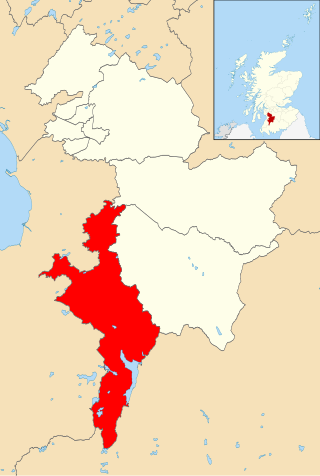
Elections to Cumnock and Doon Valley District Council were held on 7 May 1992, on the same day as the other Scottish local government elections. This was the final election to the district council which was abolished in 1995 along with Kilmarnock and Loudoun District Council and replaced by East Ayrshire Council following the implementation of the Local Government etc. (Scotland) Act 1994. The regional council, Strathclyde was also abolished and the new unitary authority took on its responsibilities.

Cumnock and New Cumnock is one of the nine electoral wards of East Ayrshire Council. Created in 2007, the ward elects four councillors using the single transferable vote electoral system and covers an area with a population of 13,210 people.

Doon Valley is one of the nine electoral wards of East Ayrshire Council. Created in 2007, the ward elects three councillors using the single transferable vote electoral system and covers an area with a population of 11,592 people.
The first elections to East Ayrshire Council were held on 6 April 1995, on the same day as the 28 other Scottish local government elections. The council was created from the former Cumnock and Doon Valley and Kilmarnock and Loudoun district councils and assumed some of the responsibilities of the former Strathclyde Regional Council following the implementation of the Local Government etc. (Scotland) Act 1994.
Elections to Cumnock and Doon Valley District Council were held on 5 May 1988, on the same day as the other Scottish local government elections. This was the fifth election to the district council following the local government reforms in the 1970s.
Mauchline was one of 32 electoral wards of East Ayrshire Council. Originally created in 1974, the ward was initially within Cumnock and Doon Valley District Council before the local government reforms in the 1990s. The ward elected one councillor using the first-past-the-post voting electoral system.
Patna and Dalrymple was one of 32 electoral wards of East Ayrshire Council. Originally created in 1974, the ward was initially within Cumnock and Doon Valley District Council before the local government reforms in the 1990s. The ward elected one councillor using the first-past-the-post voting electoral system.
Dalmellington was one of 32 electoral wards of East Ayrshire Council. Originally created in 1974, the ward was initially within Cumnock and Doon Valley District Council before the local government reforms in the 1990s. The ward elected one councillor using the first-past-the-post voting electoral system.
New Cumnock was one of 32 electoral wards of East Ayrshire Council. Originally created in 1974, the ward was initially within Cumnock and Doon Valley District Council before the local government reforms in the 1990s. The ward elected one councillor using the first-past-the-post voting electoral system.
Muirkirk, Lugar and Logan was one of 32 electoral wards of East Ayrshire Council. Originally created in 1974 as Lugar, Logan and Muirkirk before being renamed in 1999, the ward was initially within Cumnock and Doon Valley District Council before the local government reforms in the 1990s. The ward elected one councillor using the first-past-the-post voting electoral system.
Auchinleck was one of 32 electoral wards of East Ayrshire Council. Originally created in 1974, the ward was initially within Cumnock and Doon Valley District Council before it was abolished in 1984. Following the local government reforms in the 1990s, the ward was reestablished in 1999 as part of East Ayrshire. The ward elected one councillor using the first-past-the-post voting electoral system.
Cumnock Burgh was one of 10 electoral wards of Cumnock and Doon Valley District Council. Created in 1974, the ward elected one councillor using the first-past-the-post voting electoral system.
Old Cumnock Parish was one of 10 electoral wards of Cumnock and Doon Valley District Council. Created in 1974, the ward elected one councillor using the first-past-the-post voting electoral system.
Catrine and Sorn was one of 10 electoral wards of Cumnock and Doon Valley District Council. Created in 1974, the ward elected one councillor using the first-past-the-post voting electoral system.
Cumnock East was one of 32 electoral wards of East Ayrshire Council. Originally created in 1984, the ward was initially within Cumnock and Doon Valley District Council before the local government reforms in the 1990s. The ward elected one councillor using the first-past-the-post voting electoral system.
Cumnock South and Old Cumnock was one of 30 electoral wards of East Ayrshire Council. Originally created in 1984, the ward was initially within Cumnock and Doon Valley District Council before the local government reforms in the 1990s. The ward elected one councillor using the first-past-the-post voting electoral system.
Cumnock West and Auchinleck was one of 30 electoral wards of East Ayrshire Council. Originally created in 1984, the ward was initially within Cumnock and Doon Valley District Council before the local government reforms in the 1990s. The ward elected one councillor using the first-past-the-post voting electoral system.
Catrine, Sorn and North Auchinleck was one of 30 electoral wards of East Ayrshire Council. Originally created in 1984, the ward was initially within Cumnock and Doon Valley District Council before the local government reforms in the 1990s. The ward elected one councillor using the first-past-the-post voting electoral system.
Drongan, Stair and Rankinston was one of 32 electoral wards of East Ayrshire Council. Created in 1999, the ward elected one councillor using the first-past-the-post voting electoral system.
Ochiltree, Skares, Netherthird and Craigens was one of 32 electoral wards of East Ayrshire Council. Created in 1999, the ward elected one councillor using the first-past-the-post voting electoral system.


